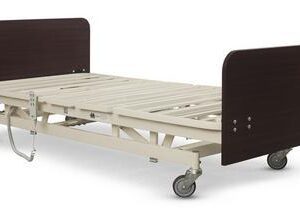Bariatric Beds
Bariatric beds are designed explicitly for indisposed people who can’t move on their own. They are heavy-duty beds that are wider than a standard hospital bed to be able to accommodate larger individuals. These beds are usually found in rehabilitation centers and in patients’ homes.
There are many bariatric beds on the market, so choosing the right one can sometimes feel a little bit overwhelming. If you’re having a hard time figuring out what bed size you need and what to look for when buying one, keep reading, and we’ll highlight the most important features you should consider.
Showing all 3 results
The Size and Weight Capacity
A typical hospital bed is between 37 and 39 inches wide and 80 inches long. In comparison, bariatric beds are between 36 and 60 inches wide and up to 88 inches in length. Some more advanced models allow you to adjust the width at will, and they are commonly known as convertible bariatric beds.
Since most bariatric beds are made to accommodate bulkier individuals, they are very sturdy to avoid mechanical failure. They have exceptionally strong frames built for people who weigh up to 1,000lbs. Like standard hospital beds, these long-term care beds also have an adjustable height, and they have built-in wheels for easier moving. The more advanced models have built-in motors that allow users to adjust their mattresses with a few simple presses of a button.
How to Choose A Bariatric Bed
There are a few essential things you should consider before buying a bariatric bed. The dimensions are the most important consideration. You should first measure the room where the bed will be to make sure that it fits and that there’s enough room to move it around. Cramped spaces and smaller rooms could prevent the patient from using the bed as intended, which can result in injuries.
The general rule is to make sure that the bed has at least five feet of clearance on all sides. Then, you have to think about if you want a manual or an electric model. Manual models are generally more affordable, and you adjust their height and position with specially designed cranks. Electric models have built-in motors controlled with a wired or wireless remote. The latter option is a better choice for immobilized patients and those who can’t adjust their position manually.
The Mattress
The size of the bariatric bed you buy defines the size of the mattress it can support. All bariatric beds are designed to provide full support and extra stability, but the mattress you choose will make the most significant difference when it comes to comfort.
If the patient in question can get out of bed with assistance, you should always look for a mattress with higher weight distribution. On the other hand, if the patient is immobilized completely, a softer mattress is a better choice. Specialty mattresses that allow lateral rotation and other functions are also a good choice.
Final Words
Now that you know how to choose a bariatric bed, you should be able to find the best option to cater to the patient’s needs. As long as you make sure that the bed frame is strong enough to support the patient’s weight and that the room it will sit in is large enough, you should be just fine.



